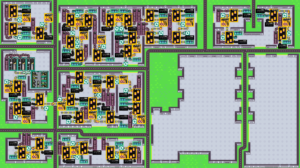Factory Idle: Clog
I keep thinking “Tonight, I’m going to pay minimal attention to Factory Idle and resume playing Munch’s Oddysee“, and I keep spending all my gaming time on Factory Idle anyway. It’s just a more interesting game! This is largely because Munch’s Oddysee wears every aspect of its gameplay on its sleeve, while in Factory Idle, I keep discovering non-obvious twists.
The latest revelation came in with bullet makers. These are devices that, in their default state, periodically use 3 steel and 2 explosives to produce 2 bullets. The novel thing about them is that they’re exactly 1 tile in size. Most things are 2×2 or larger, except buyers, which tend to be skinny — 2×1 for a coal buyer, 1×3 for oil. My first thought about the smaller size was that it would be a tremendous convenience, because most of my struggles with the factory layout were about fitting things into small spaces. But a 1×1 building has only four units of edge, which greatly constrains the placement of conveyor belts. In particular, I try to keep my inputs separated, because mixing multiple items on a single belt tends to create clogs whenever production isn’t perfectly balanced. Well, if the steel and the explosives are on different feeds, the inputs and output from a bullet maker use up all but one side. This makes it no less tricky to place than a larger item.
In fact, as I upgrade production, I’m starting to have input/output problems all around. Each belt can only convey one item per tick, so if a building produces items faster than that, it needs multiple output belts to carry it all. This eats into the space you want to use for buildings. One thing I’ve been doing to mitigate this: where possible, criss-cross the belts. Belts can meet at right angles without affecting each other. I had avoided doing this at first, because the result was ugly, and made the flow of items less comprehensible. But now, I see it as a way of getting two beltsworth of conveyance out of a single tile.
 Comments(0)
Comments(0)